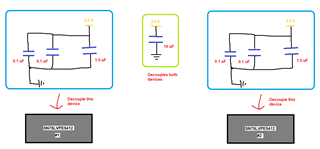Other Parts Discussed in Thread: DS320PR1601, DS320PR410, SN75LVPE5412, SN75LVPE5421
Tool/software:
(Also applicable to DS320PR410, DS320PR1601, SN75LVPE5412, and SN75LVPE5421).
The datasheets for TI DS320PRxx and SN75LVPE5xx redrivers recommend the following sizes and numbers of power supply decoupling capacitors:
- 0.1 uF, one for each VCC pin on a redriver
- 1.0 uF, one for each redriver
- 10 uF, one for each power bus that supplies power to one or more redrivers
What purpose do each of these capacitors serve, and what is the best way to arrange or structure them?


